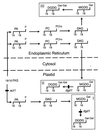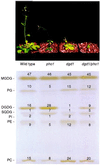DGD1-independent biosynthesis of extraplastidic galactolipids after phosphate deprivation in Arabidopsis
- PMID: 10973486
- PMCID: PMC27079
- DOI: 10.1073/pnas.180320497
DGD1-independent biosynthesis of extraplastidic galactolipids after phosphate deprivation in Arabidopsis
Abstract
The galactolipids, mono- and digalactosyldiacylglycerol (DGDG), are the most common nonphosphorous lipids in the biosphere and account for 80% of the membrane lipids found in green plant tissues. These lipids are major constituents of photosynthetic membranes (thylakoids), and a large body of evidence suggests that galactolipids are associated primarily with plastid membranes in seed plants. A null-mutant of Arabidopsis (dgd1), which lacks the DGDG synthase (DGD1) resulting in a 90% reduction in the amount of DGDG under normal growth conditions, accumulated DGDG after phosphate deprivation up to 60% of the amount present in the wild type. This observation suggests the existence of a DGD1-independent pathway of galactolipid biosynthesis. The fatty acid composition of the newly formed DGDG was distinct, showing an enrichment of 16-carbon fatty acids in the C-1 position of the glycerol backbone of DGDG. Roots with their rudimentary plastids accumulated large amounts of DGDG after phosphate deprivation, suggesting that this galactolipid may be located in extraplastidic membranes. Corroborating evidence for this hypothesis was obtained directly by fractionation of subcellular membranes from leaf tissue and indirectly by lipid analysis of the phosphate-deprived fad3 mutant primarily deficient in extraplastidic fatty acid desaturation. The discovery of extraplastidic DGDG biosynthesis induced by phosphate deprivation has revealed a biochemical mechanism for plants to conserve phosphate. Apparently, plants replace phospholipids with nonphosphorous galactolipids if environmental conditions such as phosphate deprivation require this for survival.
Figures




Similar articles
-
Can digalactosyldiacylglycerol substitute for phosphatidylcholine upon phosphate deprivation in leaves and roots of Arabidopsis?Biochem Soc Trans. 2000 Dec;28(6):729-32. Biochem Soc Trans. 2000. PMID: 11171187
-
Galactolipids not associated with the photosynthetic apparatus in phosphate-deprived plants.J Photochem Photobiol B. 2001 Aug 15;61(1-2):46-51. doi: 10.1016/s1011-1344(01)00144-0. J Photochem Photobiol B. 2001. PMID: 11485847
-
Digalactosyldiacylglycerol synthesis in chloroplasts of the Arabidopsis dgd1 mutant.Plant Physiol. 2002 Mar;128(3):885-95. doi: 10.1104/pp.010780. Plant Physiol. 2002. PMID: 11891245 Free PMC article.
-
DGDG and Glycolipids in Plants and Algae.Subcell Biochem. 2016;86:51-83. doi: 10.1007/978-3-319-25979-6_3. Subcell Biochem. 2016. PMID: 27023231 Review.
-
Galactolipids rule in seed plants.Trends Plant Sci. 2002 Mar;7(3):112-8. doi: 10.1016/s1360-1385(01)02216-6. Trends Plant Sci. 2002. PMID: 11906834 Review.
Cited by
-
Glyceroglycolipid Metabolism Regulations under Phosphate Starvation Revealed by Transcriptome Analysis in Synechococcus elongatus PCC 7942.Mar Drugs. 2020 Jul 13;18(7):360. doi: 10.3390/md18070360. Mar Drugs. 2020. PMID: 32668657 Free PMC article.
-
Dynamic gene expression changes in response to micronutrient, macronutrient, and multiple stress exposures in soybean.Funct Integr Genomics. 2020 May;20(3):321-341. doi: 10.1007/s10142-019-00709-9. Epub 2019 Oct 26. Funct Integr Genomics. 2020. PMID: 31655948 Free PMC article.
-
Phosphate deprivation induces transfer of DGDG galactolipid from chloroplast to mitochondria.J Cell Biol. 2004 Dec 6;167(5):863-74. doi: 10.1083/jcb.200407022. Epub 2004 Nov 29. J Cell Biol. 2004. PMID: 15569715 Free PMC article.
-
Phosphate deficiency modifies lipid composition and seed oil production in camelina.Plant Sci. 2023 May;330:111636. doi: 10.1016/j.plantsci.2023.111636. Epub 2023 Feb 13. Plant Sci. 2023. PMID: 36791961 Free PMC article.
-
Photosynthetic response to increased irradiance correlates to variation in transcriptional response of lipid-remodeling and heat-shock genes.Plant Direct. 2018 Jul 10;2(7):e00069. doi: 10.1002/pld3.69. eCollection 2018 Jul. Plant Direct. 2018. PMID: 31245733 Free PMC article.
References
-
- Minnikin D E, Abdolrahimzadeh H, Baddiley J. Nature (London) 1974;249:268–269. - PubMed
-
- Benning C, Huang Z H, Gage D A. Arch Biochem Biophys. 1995;317:103–111. - PubMed
-
- Güler S, Seeliger A, Härtel H, Renger G, Benning C. J Biol Chem. 1996;271:7501–7507. - PubMed
-
- Benning C. Annu Rev Plant Physiol Plant Mol Biol. 1998;49:53–75. - PubMed
Publication types
MeSH terms
Substances
LinkOut - more resources
Full Text Sources
Other Literature Sources
Molecular Biology Databases

